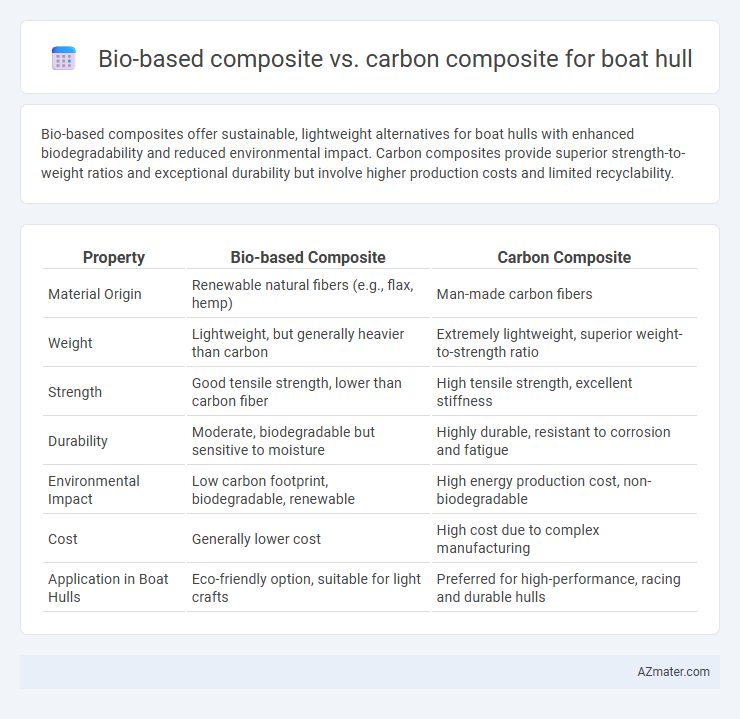Bio-based composites offer sustainable, lightweight alternatives for boat hulls with enhanced biodegradability and reduced environmental impact. Carbon composites provide superior strength-to-weight ratios and exceptional durability but involve higher production costs and limited recyclability.
Table of Comparison
| Property | Bio-based Composite | Carbon Composite |
|---|---|---|
| Material Origin | Renewable natural fibers (e.g., flax, hemp) | Man-made carbon fibers |
| Weight | Lightweight, but generally heavier than carbon | Extremely lightweight, superior weight-to-strength ratio |
| Strength | Good tensile strength, lower than carbon fiber | High tensile strength, excellent stiffness |
| Durability | Moderate, biodegradable but sensitive to moisture | Highly durable, resistant to corrosion and fatigue |
| Environmental Impact | Low carbon footprint, biodegradable, renewable | High energy production cost, non-biodegradable |
| Cost | Generally lower cost | High cost due to complex manufacturing |
| Application in Boat Hulls | Eco-friendly option, suitable for light crafts | Preferred for high-performance, racing and durable hulls |
Introduction to Composite Materials in Boat Hulls
Bio-based composites for boat hulls leverage natural fibers and renewable resins, offering enhanced sustainability and reduced environmental impact compared to traditional materials. Carbon composites provide superior strength-to-weight ratios and durability, leading to improved performance and fuel efficiency in marine vessels. Selecting between bio-based and carbon composites depends on balancing eco-friendly benefits with the technical demands of boat hull construction.
Overview of Bio-Based Composites
Bio-based composites for boat hulls utilize natural fibers such as flax, hemp, or jute combined with bio-resins, offering a sustainable alternative to traditional materials. These composites provide excellent strength-to-weight ratios while reducing environmental impact through renewable resources and lower carbon footprints. Despite slightly lower mechanical properties compared to carbon composites, bio-based composites enhance biodegradability and facilitate easier recycling processes in marine applications.
Understanding Carbon Composites
Carbon composites, composed of carbon fibers embedded in a resin matrix, offer exceptional strength-to-weight ratios and superior stiffness for boat hull construction, significantly enhancing performance and fuel efficiency. Compared to bio-based composites, carbon composites provide higher durability and resistance to corrosion, making them ideal for high-performance marine applications. Their advanced material properties contribute to reduced maintenance costs and extended service life, crucial factors in competitive and recreational boating.
Mechanical Strength and Durability Comparison
Bio-based composites for boat hulls offer high sustainability with mechanical strength reaching up to 250 MPa tensile strength, suitable for moderate load-bearing applications. Carbon composites provide superior mechanical strength exceeding 600 MPa tensile strength and exceptional durability, making them ideal for high-performance marine environments. While bio-based composites demonstrate good impact resistance and biodegradability, carbon composites outperform in fatigue resistance and long-term structural integrity under harsh sea conditions.
Weight and Performance Analysis
Bio-based composites for boat hulls offer significant weight reduction compared to traditional materials, with densities often ranging between 1.2 to 1.5 g/cm3, enhancing fuel efficiency and maneuverability. Carbon composites deliver superior strength-to-weight ratios, exhibiting tensile strengths up to 700 MPa and stiffness exceeding 70 GPa, resulting in exceptional performance under dynamic marine conditions. While carbon composites provide unmatched rigidity and durability, bio-based composites contribute sustainability benefits while maintaining competitive performance for lightweight maritime applications.
Environmental Impact and Sustainability
Bio-based composites for boat hulls significantly reduce carbon footprint by utilizing renewable natural fibers such as flax or hemp combined with biodegradable resins, enhancing biodegradability and lowering reliance on fossil fuels compared to conventional carbon composites. Carbon composites, while offering superior strength-to-weight ratios and durability, involve energy-intensive manufacturing processes and generate non-recyclable waste that pose environmental challenges. Choosing bio-based composites supports sustainable boating industry practices by reducing environmental impact, promoting circular economy principles, and facilitating end-of-life disposal through compostability or recycling.
Cost Considerations and Availability
Bio-based composites for boat hulls offer cost advantages due to the lower price of renewable raw materials like flax or hemp fibers compared to carbon fiber, which remains expensive due to complex manufacturing and limited supply chains. Availability of bio-based fibers is generally higher and more sustainable, supporting local agriculture and reducing dependency on specialized carbon fiber suppliers concentrated in certain regions. Despite lower material costs, bio-based composites may require additional processing for durability and water resistance, slightly impacting total production expenses compared to the premium, high-performance carbon composites favored for advanced marine applications.
Maintenance and Lifespan
Bio-based composites for boat hulls generally offer easier maintenance due to their natural fiber content, which improves impact resistance and reduces micro-cracking compared to carbon composites. Carbon composites excel in lifespan, delivering superior strength-to-weight ratios and prolonged durability under harsh marine conditions, but often require specialized repair techniques and regular inspections to maintain performance. The choice depends on balancing initial maintenance effort with long-term durability and repair costs.
Industry Adoption and Case Studies
Bio-based composites are increasingly adopted in the boat hull industry due to their sustainability and reduced environmental impact, with key case studies such as the PlantProbe research project demonstrating comparable mechanical properties to traditional materials. Carbon composites remain favored in high-performance marine applications for their superior strength-to-weight ratio and durability, evidenced by widespread use in racing yachts like those in the America's Cup. Industry adoption trends indicate a growing shift towards bio-based composites in recreational and small commercial vessels, driven by regulatory pressures and consumer demand for eco-friendly alternatives.
Future Trends in Boat Hull Materials
Bio-based composites are gaining traction for boat hulls due to their sustainability, biodegradability, and reduced environmental impact compared to traditional carbon composites, which offer superior strength-to-weight ratios and high performance. Advances in resin technology and natural fiber treatments are enhancing the durability and water resistance of bio-based composites, making them increasingly competitive for marine applications. Future trends indicate a hybrid approach combining bio-based fibers with carbon reinforcements to optimize strength, reduce carbon footprint, and meet evolving regulatory and consumer demands for greener boating solutions.

Infographic: Bio-based composite vs Carbon composite for Boat hull
 azmater.com
azmater.com